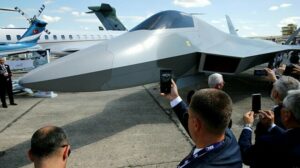Cevheri Güven
After its removal from the international program for the new generation F-35 stealth fighter jets, Turkey intensified its cooperation with the UK to manufacture its own fighter jets. Ankara’s National Combat Airplane (MMU) project involves producing the TF-X (Turkish Fighter – X), which is expected to be equipped with a special engine designed by Rolls Royce. Turkey is receiving technology transfer and assistance from London for the plane’s software and critical components.
For the project, to which President Recep Tayyip Erdoğan frequently refers in his election campaigns, Turkey has begun taking concrete steps in coordination with its ally. British Aerospace Systems (BAE Systems) is the main partner in the project.
Abdurrahman Şeref Can, a high-ranking aerospace official from the Presidency of the Defense Industries (SSB), stated during a defense fair he attended last week that the planned aircraft will be a fourth-generation fighter jet and that its engines would be provided by Rolls Royce if an agreement can be finalized.
BAE Systems as the main partner
When Ankara announced its plans for a homemade fighter jet, the first proposal came from Rolls Royce, which suggested jointly developing an engine. However, no agreement has been concluded due to some of the conditions put forward by the company.
Dominick Chilcott, the UK ambassador to Turkey, told the state-run TRT World in December 2020 that the first stage of the work for the TF-X was ahead of schedule and that the main partner, BAE Systems, was satisfied with the progress made.
According to the schedule provided by Chilcott, the second stage will begin by the end of 2021 or the beginning of 2022.

Delay in agreement for engine
The most critical component of the MMU project, the engine, remains an unresolved issue, with the sides at an impasse over the intellectual property rights of the plane and its sale to third countries. Beginning in 2010 Turkey had contacted US and Swedish firms for the engine yet settled on the British company after ties with London began to improve in 2016.
British technology in Turkish drone systems
London has been supporting Turkey in the air for a while. Armed drones manufactured by a company owned by Selçuk Bayraktar, Erdoğan’s son-in-law, has been the most visible field of cooperation.
The TB2 drone, which Ankara has used in the clashes in Libya, Syria and Nagorno-Karabakh, enjoys the support of the Brighton-based EDO MBM Technology Ltd. In 2019, The Guardian published a report titled “Revealed: How UK technology fuelled Turkey’s rise to global drone power.”
Turkey’s greatest defense industry project
With MMU, Turkey also aims to become one of the few countries in the world that have the infrastructure and technology to develop a fifth-generation fighter jet. The project is the largest among Turkey’s defense initiatives, and of the $20 billion allocated to it, the UK will get lion’s share.
Erdoğan had pointed to the year 2023 for the plane to make its debut. For 2023, the centennial of the Turkish Republic, Erdoğan has made many promises thus far. While the SSB confirms the goal put forward by Erdoğan, it sets the first flight date as 2025. With five years of test runs, the aircraft will make it into the Turkish Air Force’s inventory by 2030 in the best case scenario.
The agreement between Turkish Aerospace Industries (TUSAŞ) and BAE Systems was concluded in 2017. The British company also carried out the recruitment of engineers to work for the project in Turkey.

